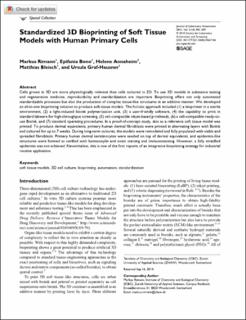Please use this identifier to cite or link to this item:
https://doi.org/10.21256/zhaw-1749| Publication type: | Article in scientific journal |
| Type of review: | Peer review (publication) |
| Title: | Standardized 3D bioprinting of soft tissue models with human primary cells |
| Authors: | Rimann, Markus Bono, Epifania Annaheim, Helene Bleisch, Matthias Graf-Hausner, Ursula |
| DOI: | 10.21256/zhaw-1749 10.1177/2211068214567146 |
| Published in: | SLAS Technology: Translating Life Sciences Innovation |
| Volume(Issue): | 21 |
| Issue: | 4 |
| Page(s): | 496 |
| Pages to: | 509 |
| Issue Date: | 2015 |
| Publisher / Ed. Institution: | Sage |
| Publisher / Ed. Institution: | Thousand Oaks |
| ISSN: | 2472-6303 2472-6311 |
| Language: | English |
| Subjects: | Soft tissue models; 3D cell culture; Bioprinting; Automation, standardization |
| Subject (DDC): | 610: Medicine and health |
| Abstract: | Cells grown in 3D are more physiologically relevant than cells cultured in 2D. To use 3D models in substance testing and regenerative medicine, reproducibility and standardization are important. Bioprinting offers not only automated standardizable processes but also the production of complex tissue-like structures in an additive manner. We developed an all-in-one bioprinting solution to produce soft tissue models. The holistic approach included (1) a bioprinter in a sterile environment, (2) a light-induced bioink polymerization unit, (3) a user-friendly software, (4) the capability to print in standard labware for high-throughput screening, (5) cell-compatible inkjet-based printheads, (6) a cell-compatible ready-to-use BioInk, and (7) standard operating procedures. In a proof-of-concept study, skin as a reference soft tissue model was printed. To produce dermal equivalents, primary human dermal fibroblasts were printed in alternating layers with BioInk and cultured for up to 7 weeks. During long-term cultures, the models were remodeled and fully populated with viable and spreaded fibroblasts. Primary human dermal keratinocytes were seeded on top of dermal equivalents, and epidermis-like structures were formed as verified with hematoxylin and eosin staining and immunostaining. However, a fully stratified epidermis was not achieved. Nevertheless, this is one of the first reports of an integrative bioprinting strategy for industrial routine application. |
| URI: | https://digitalcollection.zhaw.ch/handle/11475/3280 |
| Fulltext version: | Published version |
| License (according to publishing contract): | Licence according to publishing contract |
| Departement: | Life Sciences and Facility Management |
| Appears in collections: | Publikationen Life Sciences und Facility Management |
Files in This Item:
| File | Description | Size | Format | |
|---|---|---|---|---|
| 2016_Rimann_Standardized_3D_Bioprinting_JournalLaboratoryAutomation.pdf | 652.28 kB | Adobe PDF |  View/Open |
Show full item record
Rimann, M., Bono, E., Annaheim, H., Bleisch, M., & Graf-Hausner, U. (2015). Standardized 3D bioprinting of soft tissue models with human primary cells. SLAS Technology: Translating Life Sciences Innovation, 21(4), 496–509. https://doi.org/10.21256/zhaw-1749
Rimann, M. et al. (2015) ‘Standardized 3D bioprinting of soft tissue models with human primary cells’, SLAS Technology: Translating Life Sciences Innovation, 21(4), pp. 496–509. Available at: https://doi.org/10.21256/zhaw-1749.
M. Rimann, E. Bono, H. Annaheim, M. Bleisch, and U. Graf-Hausner, “Standardized 3D bioprinting of soft tissue models with human primary cells,” SLAS Technology: Translating Life Sciences Innovation, vol. 21, no. 4, pp. 496–509, 2015, doi: 10.21256/zhaw-1749.
RIMANN, Markus, Epifania BONO, Helene ANNAHEIM, Matthias BLEISCH und Ursula GRAF-HAUSNER, 2015. Standardized 3D bioprinting of soft tissue models with human primary cells. SLAS Technology: Translating Life Sciences Innovation. 2015. Bd. 21, Nr. 4, S. 496–509. DOI 10.21256/zhaw-1749
Rimann, Markus, Epifania Bono, Helene Annaheim, Matthias Bleisch, and Ursula Graf-Hausner. 2015. “Standardized 3D Bioprinting of Soft Tissue Models with Human Primary Cells.” SLAS Technology: Translating Life Sciences Innovation 21 (4): 496–509. https://doi.org/10.21256/zhaw-1749.
Rimann, Markus, et al. “Standardized 3D Bioprinting of Soft Tissue Models with Human Primary Cells.” SLAS Technology: Translating Life Sciences Innovation, vol. 21, no. 4, 2015, pp. 496–509, https://doi.org/10.21256/zhaw-1749.
Items in DSpace are protected by copyright, with all rights reserved, unless otherwise indicated.